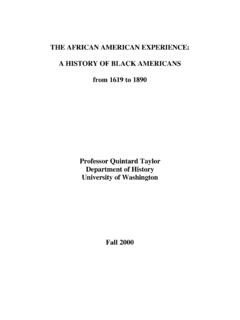Transcription of History of Gangs in the United States - SAGE Publications …
1 1 History of Gangs in the United States IntroductionA widely respected chronicler of British crime, Luke Pike (1873), reported the first active Gangs in Western civilization. While Pike documented the existence of Gangs of highway robbers in England during the 17th century, it does not appear that these Gangs had the features of modern-day, serious street Gangs . Later in the 1600s, London was terrorized by a series of organized Gangs calling themselves the Mims, Hectors, Bugles, Dead Boys [and they] fought pitched battles among themselves dressed with colored ribbons to distinguish the different factions (Pearson, 1983, p.)
2 188). According to Sante (1991), the History of street Gangs in the United States began with their emer-gence on the East Coast around 1783, as the american Revolution ended. These Gangs emerged in rapidly growing eastern cities, out of the conditions created in large part by multiple waves of large-scale immigration and urban chapter examines the emergence of gang activity in four major regions, as classified by the Census Bureau: the Northeast, Midwest, West, and South. The purpose of this regional focus is to develop a better understanding of the origins of gang activity and to examine regional migration and cultural influences on Gangs themselves.
3 Unlike the South, in the Northeast, Midwest, and West regions, major phases characterize gang emergence. Table displays these Gangs IN AMERICA S COMMUNITIESN ortheast Region (mainly New York City)First period: 1783 1850s The first ganglike groups emerged immediately after the american Revolution ended, in 1783, among the White European immigrants (mainly English, Germans, and Irish). Serious ganging in New York City commenced around 1820. The first well-organized gang formed in 1826 in the back room of Rosanna Peers s period: 1860 1920s The Chinese began setting up their own highly structured tongs around 1860.
4 The arrival of the Poles, Italians, Austrians, and other peoples in the period 1890 to 1930 created even worse slum conditions. The first police war on Gangs occurred in New York City in 1915 period: 1930s 1980s Beginning in the 1930s, the most intensive gang activity in New York City shifted from downtown (Manhattan) to both northern (East Harlem and the Bronx) and southeastern (Brooklyn) locations in the metropolitan area. More fighting Gangs emerged after the arrival of african american migrants from the South and Latino immigrant groups (from Latin America, the Caribbean, and Puerto Rico) in the 1930s and 1940s.
5 Black Gangs appeared by the 1950s. In the late 1950s, a slum clearance project moved several thousand poor Puerto Rican and african american families into high-rise public housing in East Harlem. During the 1980s, new Asian and non Puerto Rican Latino immigrants populated Region (mainly Chicago)First period: 1860s 1920s Chicago s first street Gangs developed among White immigrants along ethnic lines in the 1860s particularly Irish, German, and Lithuanian people. In the 1920s, Gangs became entrenched in the patronage networks operated by ward politicians, with notorious criminals and rum-runners, the most notable of which was the Al Capone period: 1940s 1970s Following the 1919 race riot, Black males formed Gangs to confront hostile White gang members who were terrorizing the african american communities.
6 Mexican american Gangs likely formed in the 1950s, if not earlier. Chicago s largely african american gang problem exploded in the 1960s, with more Gangs and more violence. Public housing high-rises became gang incubators and drug turf battlegrounds beginning in the Key Timelines in Street gang HistoryChapter 1 History of Gangs in the United States 3 West Region (mainly Los Angeles)First period: 1890s 1920s Ganglike groups of Mexican descent appeared in the West region in the 1890s. The first Los Angeles Mexican american Gangs likely formed in the period: 1940s 1950s Two events in the 1940s stimulated growth of Mexican american Gangs in West: the Sleepy Lagoon murder and the zoot suit riots.
7 Mexican immigration accelerated in the early period: 1950s 1980s By the 1950s, african american Gangs in Los Angeles were beginning to assume a street gang presence. african american Gangs were well established by the 1960s in low-income housing projects. Mexican american Gangs steadily grew following the Vietnam War, the War on Poverty, and the Chicano movement of the 1960s and 1970s. By the 1970s, street Gangs had emerged in most populated areas across California. In the 1980s, the gang culture melded with crack cocaine dealing and consumption in the african american RegionFirst period: 1970s 1990s gang activity likely did not emerge in the southern States prior to the 1970s.
8 As of 1980, only Miami and San Antonio were considered to have a moderately serious gang problem. Several southern States saw sharp increases in gang activity in multiple cities and counties by 1995. Before the end of the 20th century, the South region matched the other major regions in the prevalence of gang activity. Houston emerged in the past decade as a major gang Influence of Population Migration Patterns on gang EmergenceThree large groups of early immigrants populated the Northeast and Midwest regions of the United States . According to Pincus and Erlich (1999), so-called old immigrants first came, predominantly from England and English territories, and also Dutch, German, Swedish, and Scandinavian peoples.
9 In the second large wave, from 1865 to 1890, approximately 11 million immigrants arrived from mainly northern and western regions of Europe, especially Great Britain, Germany, and Scandinavia (Denmark, Norway, Sweden). The third group of immigrants from countries of southern and 4 Gangs IN AMERICA S COMMUNITIES eastern Europe the Poles, Italians, Austrians and many others another 11 million or so, arrived from 1890 to 1930. Largely consisting of low-skilled, low-wage laborers, not unexpectedly, the three large immigrant surges overwhelmed the housing and welfare capacity of the young northeastern and midwestern cities, contributing directly to slum conditions and the accompanying crime problems, Gangs included.
10 Street Gangs emerged from similar conditions of social disorganization in contrast, Gangs initially grew out of the preexisting Mexican culture in the West region, and subsequent Mexican migrations continuously fueled their growth. Immigrant groups along the trail from Mexico to Los Angeles initially populated El Paso, Albuquerque, and Los Angeles. The migrants brought an embryo, or pregang, subculture called pachuco (Moore, 1978; Vigil, 1988, 1990) that quite likely began forming in El Paso (Moore, 2007a). gang emergence in the South does not appear to have been grounded in any of the preexisting conditions found in the Northeast, Midwest, and West.











